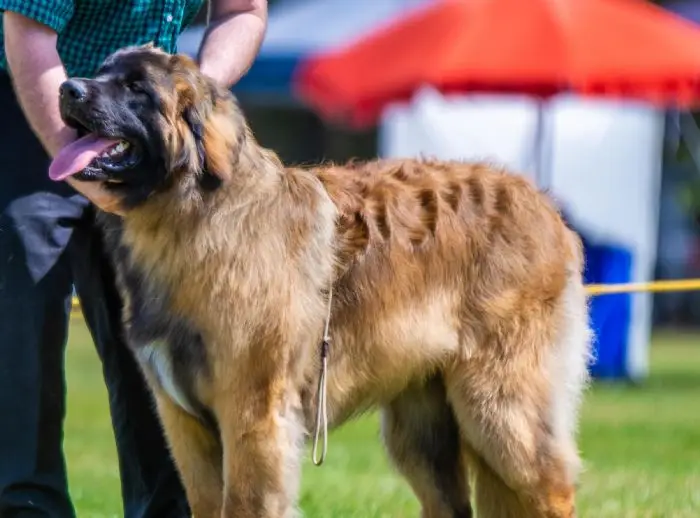Leonbergers are gentle giants known for their calm, affectionate, and loyal temperament. Bred originally as companion dogs, they are intelligent, eager to please, and typically easy to train with consistent, positive reinforcement. Despite their imposing size, Leonbergers are remarkably gentle, especially with children, making them excellent family pets. They are sociable and thrive on being part of family life, often forming strong bonds with their people. Leonbergers are also known for their patience and steadiness, though they do require regular exercise and mental stimulation to stay happy and healthy. With their majestic appearance, thick double coat, and friendly disposition, Leonbergers are both impressive and endearing companions.
Breed Standard
Here’s your text with emojis added to enhance readability and convey tone where appropriate:
📜 Translation: Mrs C. Seidler, revised by Mrs E. Peper
🌍 Origin: Germany
📅 Date of Publication of the Original Valid Standard: 04.01.1996
🐕 Utilisation: Watch 🛡️, Companion 🤝, and Family Dog 👨👩👧👦
🏷️ Classification FCI:
Group 2: Pinscher and Schnauzer, Molossoid breeds, Swiss Mountain and Cattle Dogs and other breeds 🐾
Section 2.2: Molossoid breeds, Mountain type 🏔️
Without working trial ❌🎽
📖 Brief Historical Summary
At the end of the 1830s to early 1840s, Heinrich Essig, a town councillor in Leonberg near Stuttgart, bred a black and white Newfoundland bitch with a “Barry” male from Grand St. Bernard monastery hospice 🏞️. Later, a Pyrenean Mountain Dog 🐕🦺 was added to the mix. The aim was a lion-like dog 🦁—the lion being the heraldic animal of Leonberg 🛡️.
The first dogs officially called “Leonbergers” were born in 1846 🐶. They combined excellent traits from the founding breeds.
Soon after, Leonbergers were sold globally 🌍 as status symbols. By the late 19th century, they were valued in Baden-Württemberg as preferred farm dogs 🚜, praised for watchfulness and draft work 🐾💪.
Despite dwindling numbers due to both World Wars and post-war hardships today the Leonberger is an excellent family dog, meeting modern needs with ease.
🧬 General Appearance
A large, strong, muscular yet elegant dog 🐕. Balanced build, confident calmness 🧘♂️, and a lively temperament 😄. Males are particularly powerful 💪.
📏 Important Proportions
Height at withers to body length: 9 to 10
Chest depth: nearly 50% of withers height 📐
🧠 Behaviour / Temperament
Ideal family companion 🧑🤝🧑—friendly to children 👶, obedient 👍, fearless 🦸, and adaptable to various life situations 🌍. Not shy or aggressive 🚫.
Key traits:
Self-assurance 😌
Composure 🧘
Playfulness 🎾
Willingness to obey 🤲
Good learner 📚
Noise insensitive 🔇
🐶 Head & Facial Features
Shape: Deep, elongated
Muzzle:Skull ratio: 1:1
Skull: Slightly arched 🧱
Stop: Moderately defined
Nose: Black 🖤
Muzzle: Long, slightly arched
Lips: Tight, black
Teeth: Full set, strong scissor or pincer bite 🦷
Eyes: Medium, oval, dark brown preferred 👁️
Ears: High set, medium, close to head 👂
🦴 Neck & Body
Neck: Slight curve, no dewlap
Withers: Pronounced, esp. in males
Back: Firm, straight
Loins & Croup: Strong, broad, gently sloping
Chest: Deep, broad, oval
Underline: Slight tuck
🐾 Tail & Limbs
Tail: Well-furnished, hangs straight, slight movement curve
Forelimbs: Straight, muscular
Shoulders: Long, sloping
Feet: Round, arched toes, black pads 🐾
Hindquarters: Parallel, strong angles, straight hocks
🏃♂️ Gait / Movement
Ground-covering, smooth, and even stride ✨
Front limbs extend well, hind limbs drive strongly 💨
Straight-line movement when walking or trotting 🚶♀️🐕
🧥 Coat
Texture: Medium soft to coarse, thick undercoat, never parted
Form: Mane (esp. in males), feathering on front legs, breeches on rear
Colours: Lion yellow, red, reddish brown, sandy, with black mask 🦁🎨
Markings: Black hair tips okay, small white patch/stripe on chest or toes tolerated ✅
📐 Size
Males: 72–80 cm (avg. 76 cm)
Females: 65–75 cm (avg. 70 cm)
❗ Faults
Deviation from standards should be judged by degree
Very Serious Faults include:
Shyness or aggression 😠
Severe anatomical issues 🦴
Missing or misaligned teeth 🦷
Eye or ear defects 👁️❌
Faulty tail 🌀
Wrong colours or missing mask 🎨
Excessive white 🤍
Behavioural or physical abnormalities 🚫
⚠️ Note: Males should have two normal testicles fully descended ⚖️🐾




